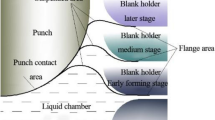Abstracts
The double-curved is the main feature of the sheet metal part, which is mainly used in automobile panels, aircraft skins, high-speed rail car bodies, etc. The forming process can easily lead to the local thinning and springback and seriously affect its forming quality. In this paper, the influence of the shear modulus of the flexible die on the thinning and springback of 6K21-T4 aluminum alloy for double-curved parts was analyzed by the numerical simulation method. Different rubber flexible die were selected for the forming process of the different double-curved parts, and the effect of the shear modulus on the thinning and springback of double-curved parts was obtained. Results show that the thickness reduction of the part formed by the rubber flexible die is reduced by 10.6% compared with that of the rigid punch forming. The maximum effective stress difference can be reduced by 67.4% and the springback can be reduced by 64.8% through optimizing the shear modulus of rubber flexible die.


















Similar content being viewed by others
Data availability
The manuscript has no associated data or the data will not be deposited.
References
Dirikolu MH, Akdemir E (2004) Computer aided modelling of flexible forming process. J Mater Process Technol 148(3):376–381
Girard AC, Grenier YJ, Mac Donald BJ (2006) Numerical simulation of axisymmetric tube bulging using a urethane rod. J Mater Process Technol 172(3):346–355
Thiruvarudchelvan S, Tan MJ (2007) Investigations into collar drawing using urethane pads. J Mater Process Technol 191(1-3):87–91
Thiruvarudchelvan S, Travis F (1990) Tube bulging with a urethane rod. J Mater Process Technol 23(2):195–209
Hassan M, Hino K, Takakura N, Yamaguchi K (2002) Friction aided deep drawing of sheet metals using polyurethane ring and auxiliary metal punch. Part 2: analysis of the drawing mechanism and process parameters. Int J Mach Tool Manu 42(5):633–642
Hassan M, Takakura N, Yamaguchi K (2002) Friction aided deep drawing of sheet metals using polyurethane ring and auxiliary metal punch. Part 1: experimental observations on the deep drawing of aluminium thin sheets and foils. Int J Mach Tool Manu 42(5):625–631
Quadrini F, Santo L, Squeo EA (2010) Flexible forming of thin aluminum alloy sheets. Int J Mod Manuf Technol 2(1):79–84
Belhassen L, Koubaa S, Wali M, Dammak F (2019) Experimental and numerical investigation of flexible bulging process of aluminum AA1050-H14 sheet metal with soft tools. Int J Adv Manuf Technol 103(9-12):4837–4846
Sun YN, Wan M, Wu XD (2012) Friction coefficient in rubber forming process of Ti-15-3 alloy. T Nonferr Metal Soc 22(12):2952–2959
Browne DJ, Battikha E (1995) Optimisation of aluminium sheet forming using a flexible die. J Mater Process Technol 55(3-4):218–223
Ramezani M, Ripin ZM, Ahmad R (2010) Sheet metal forming with the aid of flexible punch, numerical approach and experimental validation. CIRP J Manuf Sci Technol 3(3):196–203
Al-Qureshi H (2002) Analysis of simultaneous sheet metal forming operations using elastomer technique. J Mater Process Technol 125:751–755
Jin CK, Jeong MG, Kang CG (2014) Effect of rubber forming process parameters on micro-patterning of thin metallic plates. Procedia Eng 81:1439–1444
Son CY, Jeon YP, Kim YT, Kang CG (2012) Evaluation of the formability of a bipolar plate manufactured from aluminum alloy Al 1050 using the rubber pad forming process. Proc Inst Mech Eng B J Eng Manuf 226(5):909–918
Wang ZJ, Li Y (2008) Formability of 6K21-T4 car panel sheet for viscoelastic–plastic flexible-die forming. J Mater Process Technol 201(1-3):408–412
Acknowledgments
The presented investigations have been supported by the National Natural Science Foundation of China and the authors kindly acknowledge these supports.
Funding
This research was sponsored by the National Natural Science Foundation of China (No. 51875123).
Author information
Authors and Affiliations
Contributions
The corresponding author Zhong-jin Wang was responsible for determining the suitable structure and contents of this paper. He also was responsible for reviewing and editing this paper. Rui Zhang was responsible for writing this paper and analyzing all the obtained raw data.
Corresponding author
Ethics declarations
Ethical approval
This paper is new. Neither the entire paper nor any part of its content has been published or has been accepted elsewhere. It is not being submitted to any other journal as well.
Consent to participate
Not applicable.
Consent to publish
Not applicable.
Competing interests
The authors declare no conflict of interest.
Additional information
Publisher’s note
Springer Nature remains neutral with regard to jurisdictional claims in published maps and institutional affiliations.
Rights and permissions
About this article
Cite this article
Zhang, R., Wang, ZJ. Numerical simulation analysis of rubber flexible die properties on forming quality of the double-curved part for 6K21-T4 aluminum alloy. Int J Adv Manuf Technol 113, 1097–1110 (2021). https://doi.org/10.1007/s00170-021-06658-7
Received:
Accepted:
Published:
Issue Date:
DOI: https://doi.org/10.1007/s00170-021-06658-7



